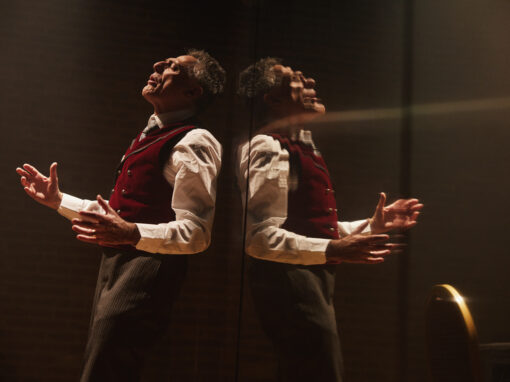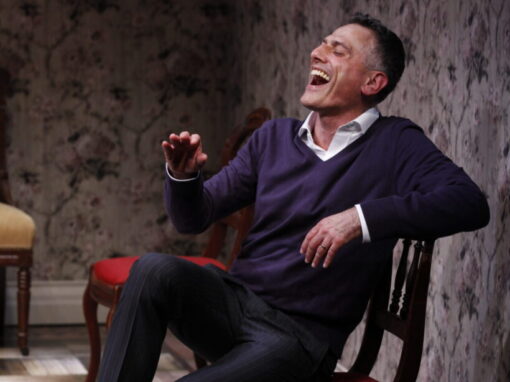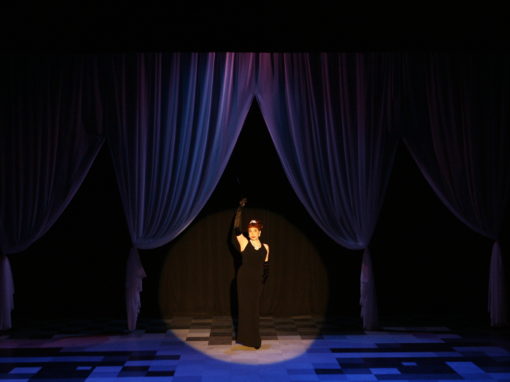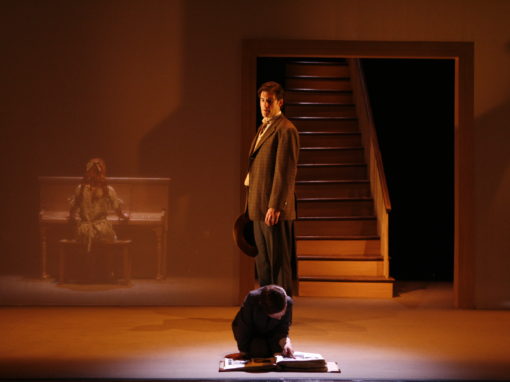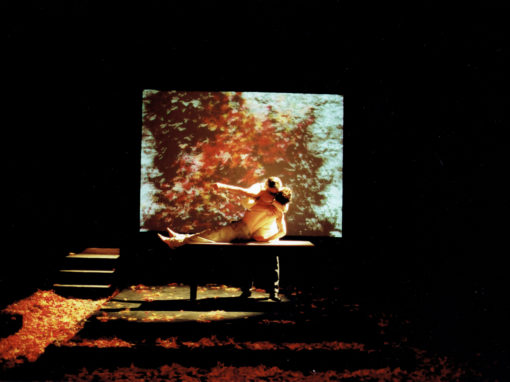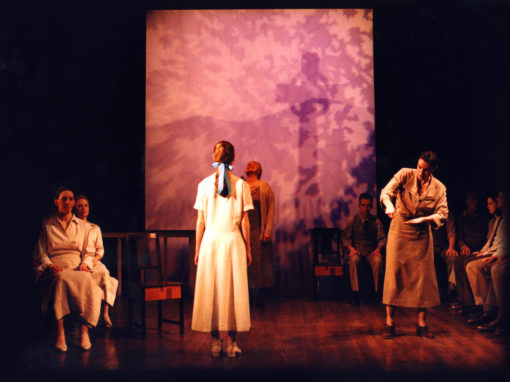Take Me to Church // by MaryKate Glenn
Theatre Artist MaryKate Glenn finds her unlikely worlds of theatre, social justice, and catholicism collide at Transport Group.
In the fall of 2018, I was in the midst of a bleary-eyed and somewhat shell-shocked return to New York. I had just moved back from a year living in Sacramento, working as a social worker at a school. I had made a very intentional, if difficult, decision to return to pursue theatre—leaving Sacramento and the community of activists, teachers, and dear friends I had built there. I cried (a lot) when my JFK-bound plane left the Sacramento airport.
New York felt cold. Way too loud. A little isolating. And very disorienting. I spent most of my first four months holding this strange psychic tension between the work I had done in California and my perception of what “working in theatre” meant in this city. I felt overstimulated and unfulfilled and underprepared and homesick for the community I had left in California.
So, when I stumbled upon Transport Group’s post on Playbill.com at 11 p.m. on a Tuesday in late November, I didn’t think twice. I thought, “Oh good, thank God—finally something I know.” The posting was seeking an assistant director/research assistant for a revival/new adaptation of a play called The Trial of the Catonsville Nine, written by Catholic priest, poet, FBI’s Most Wanted List felon, Daniel Berrigan. Okay, here we go, I thought. This was my world. And I was willing to bet that there was not a single other twenty-something theatre artist in New York who had the point of entry into this story that I did. It turns out, Jack Cummings (TG Artistic Director and director of this production) had already hired someone for the position. But I guess given my strangely extensive knowledge of Catholics who were part of the anti-war movement in the 1960s … and my likely disproportional levels of excitement about social justice work within radical socialist offshoots of Catholicism … he hired me anyhow.
I had graduated from Fordham University (a Jesuit university where Father Daniel Berrigan was living when he died in 2016) a year and a half earlier with a dual degree in theology and philosophy. The organization where I worked in Sacramento had deep ties to The Catholic Worker (“The Worker”), a social movement began by Dorothy Day and Peter Maurin in the 1930s (and which Berrigan was intimately a part of). The Worker had shaped my understanding of social justice and salvaged any semblance of a spiritual relationship I’d patched up with Catholicism. The movement birthed a community of activists, artists, workers, priests, nuns—all fiercely committed to the confrontation of injustice through nonviolent protest and direct acts of service.
Still today, there are dozens of Catholic Worker houses in cities all across the country. Their work focuses on issues ranging from ecological justice and living in right relationship with the land, to advocating for the rights of migrant workers, to providing safe living spaces for trans and queer youth, to making soup and coffee every morning for anyone in the community who needs some. (The Worker is not sanctioned by the institution of The Catholic Church…and their work frequently stands in direct contradiction to the institutional Church’s oppressive actions and ethos).
Today, you can find the two original Catholic Worker houses, and see them offering soup to guests every morning at 9 a.m., on East 1st Street in Lower Manhattan.
I’d never encountered a theatrical project that married these two worlds—theatre and this niche world of Catholic activism—so seamlessly. Transport Group’s posting on Playbill.com seemed to be an answer to the profound vocational dissonance I’d been feeling since I moved back to New York (and truthfully, much longer than that).
At the time, this was how I positioned working on The Trial of the Catonsville Nine. That is, it was a gift the universe had offered me, for it all felt very fated. It was a project that would shed light on how my two worlds of experience, which often felt at odds with each other, were going to partner, dialogue, and nourish each other in the work I made.
And it was that. But when I look back on it now, a few years and many more productions down the line, I view it first and foremost as an example of what a rehearsal process can look like, if we’re lucky. And if there’s a great deal of trust present. And grace. And what resonance this kind of rehearsal space can have once we step out into the world.
The rehearsal process was a space of deep collaboration. The piece and the process felt almost devised—as the actors will surely tell you, we didn’t have anything that resembled a finished script until…tech? Maybe? The Trial of the Catonsville Nine that audiences saw at The Abrons Arts Center in the winter of 2019 was not only a reflection on the events that occurred in Catonsville, Maryland in May of 1968, but also a reflection of the very nature of our process itself. In the finished piece, I could feel the presence not only of the text, of the artists who sat around our rehearsal table, but also of the piles of books, articles, photographs, films, and shared stories that grew and grew over our weeks of rehearsing.
The building of this production was highly horizontal in structure. That is to say, there was no hierarchy, no authoritarian voice in the room. The room felt like an open vessel that could hold all of the ideas and questions and sometimes tears and awe and awkwardness and more questions that arose over those months. Isn’t this what we speak about today, when we talk about reforming power structures in any institution, including American theatre? Toppling the vertical hierarchy and making it horizontal? Or maybe circular? I can picture the brightness of our rehearsal room overlooking Times Square on New Year’s Eve. I can remember what it felt like in that room. I can still feel that horizontal-ness, that energetic exchange, the shared sparks of creation, in my body.
I did not realize at the time how unique this was: the nature of these open channels of knowledge-exchange and question-asking that was consistent throughout the entire process. But I also realized only in retrospect the profound amount of grace and generosity it took for that room to be as collaborative as it was. Asking questions unabashedly, admitting you don’t know something (and maybe you don’t even know how to ask what you don’t know), is scary. Holding space for those questions can be heavy. Coming back the next day and doing it all again is very brave.
Transport Group’s production of The Trial of the Catonsville Nine was one specific story told through one specific lens, that of three present-day Asian American actors (Mia Katigbak, Eunice Wong, David Huynh). The questions and horrors and heartbreak and laughter and discoveries that came up were unique to our process, and unique to each individual who was a part of it. But the braveness in asking questions and holding space once they are asked could be (and I think must be) part of all of the work that we do.
When I think about what we do—what anyone does—I think in terms of work that is in communion with something outside of yourself. That is, work that lives in the world, which offers you a way to engage with the world more thoughtfully or generously or curiously and with more presence than you did before you started. I have reflected often and for a long time on this idea of social shifting, of what it takes to incrementally move a society away from oppressive and violent economic, political, and psychic structures. I have considered the many ways there are to do this: labor organizing, direct service, political organizing, voting, protesting, burning draft files, writing poetry, reading books, making art, teaching children … we could fill this whole essay with different people’s ideas of how change happens. And in fact, with Catonsville, we spent an entire process intensely studying one group’s very precise undertaking of what they believed to be necessary steps of action towards change.
As theatre artists, our work is often abstracted from the tangible, the concrete elements of injustice. In other words, we are not outside serving soup every day at a Catholic Worker house. But I do not think the indirectness of our work means it is not important. And actually, in reflecting on Catonsville today, I think the most sacred part of the work (any work, not just theatre work) comes through process itself. The rehearsal process offers artists an opportunity to decide how they’d like to build something together. At its best, the artists in the room curate their vision in unison and harmony. I’m suggesting that the model of dialogue, generosity, accountability and care we set forth in the process attunes our bodies for a certain way of engaging with people outside of our rehearsal spaces, and indeed determines how we engage with the world. The ripple effect, right?
A final important lesson I learned working on The Trial of the Catonsville Nine: when you structure a process this way and invite people in, there is a very precise lack of ego that is necessary to make this balance and collaboration function. In this way, the Catonsville process showed me the importance of building with kind people; and the centrality (necessity) of community to this work. And truly, to everything we do. Community and communion with each other was essential to The Nine as they planned to burn the papers at the Catonsville, MD draft board in May of 1968. It was essential to us in the rehearsal room as we worked to understand their story. It is essential now as I still hold some of my collaborators from that piece close to my heart as artists who make me proud and excited to be in this profession we are all in.
So, life is funny. I thought sitting in those rehearsal rooms that Catonsville was at the beginning of my work on theatre that exactly merged my two worlds. And in a way, it was. Catonsville, and the process of shaping that story, invited me to understand power, profound grace, and revolutionary action in an expanded way. A radical act does not have to look as big as a bonfire of draft cards. There is radical power in the holding of light, warmth, and gentleness in a room of people, all very different, all of whom care about each other, all asking the hard question, and all coming back the next day to tend to that light and do it again.

About the author:
MaryKate Glenn (she/her) is an artist/actor/dancer/mover from the East Coast, currently working very hard to adjust to the lack of seasons in Southern California. She is pursuing an MFA in Acting from California Institute of the Arts. BA Theology/Philosophy from Fordham University. “keep some room in your heart for the unimaginable.” ig: @mkg414
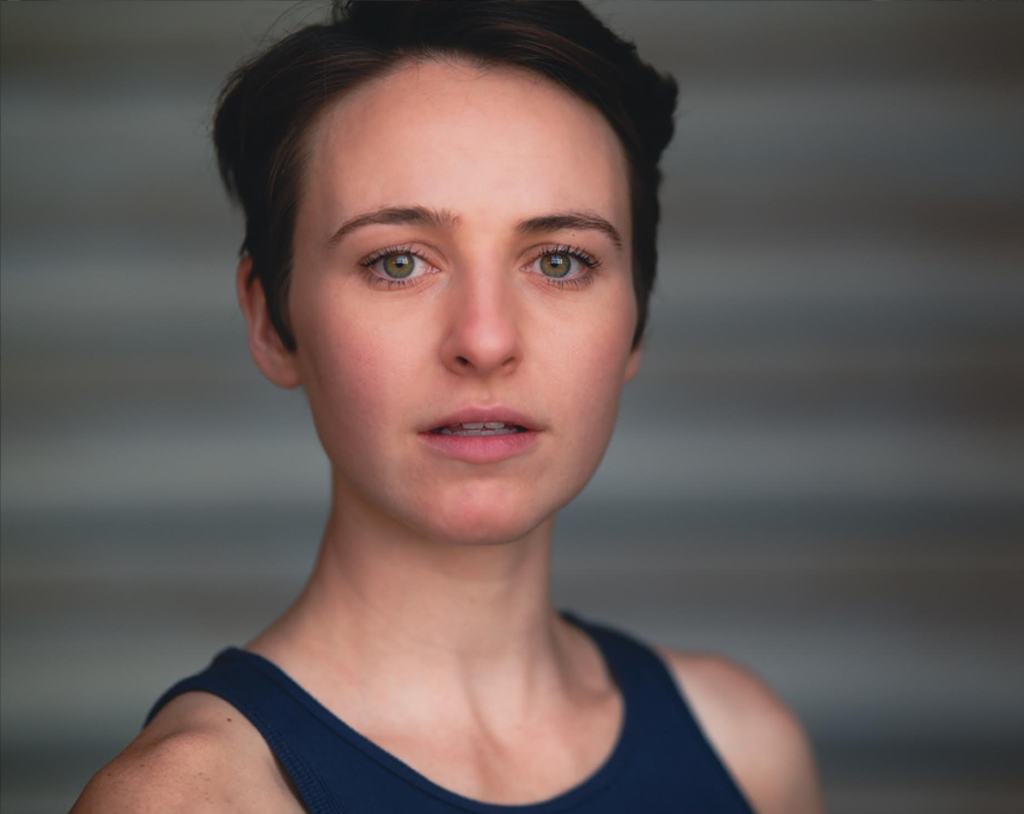
Explore Our Past Shows
